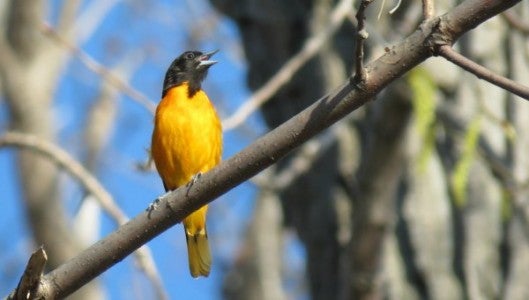Learning bird songs in the spring
Published 10:00 pm Monday, May 30, 2016
Learning to listen is very difficult. We are visual creatures that get distracted by movement and the motions around us. We don’t concentrate on what people say to each other, let alone the birds. Car alarms, traffic and planes all block our finer thoughts as the natural world gets pushed into the background. It’s difficult to block all the sounds around us, and just concentrate on the wonderful songs and calls of our native birds.
I recently took a couple of private clients out for just this purpose — to listen, and hopefully learn, a few of the birds around us – by sound. We stood along the boardwalk at a nearby nature preserve and listened.
A Yellow Warbler sang its rapid song, often rendered as “Sweet, sweet, a little more sweet.” Nearby, several Blue-gray Gnatcatchers uttered their squeaky “spee” like call notes and a Red-winged Blackbird sang its somewhat discordant “Conk-aree” song. We did our best to block out the sounds of the early morning commuting traffic and picked more birds out of the mix.
American Redstart, Gray Catbird and House Wren all added to the avian chorus, while we talked about how to identify and remember the different song types. Was it fluting, rhythmic or buzzy? How did the singer sound to us? Some are easy and repeat their names, like Whip-poor-will and Bobwhite, but many others do sound the same, I must admit.
We walked along the lake shore looking for a male Baltimore Oriole, but obviously had not yet arrived from their winter haunts. Several Orchard Orioles had already made the journey and gave us great views. Their songs are best described as a rich warbling with a flourish to finish.
It was then time to tackle some warbler songs and there’s no better place than the Blue Ridge Parkway around Asheville. Spring’s green leaves had just crept into the lower elevations, but as we climbed higher into the Blue Ridge, the leaves had barely begun to unfurl. The advantage of this was that the newly arrived birds were very easy to see.
Black-and-white Warblers are early arrivals in our woodlands. They have a very distinctive feeding habit of creeping up and down along bare trunks looking for insects in the bark crevices. Their high-pitched lisping songs are easy to hear in the slowly greening woodlands and have been likened to the squeaky wheel on a wheelbarrow.
Hooded Warblers were singing there loud “Weeta, weeta, weet-eo” songs and a Kentucky Warbler was churring away like a somewhat flat-sounding Carolina Wren. Using descriptive terms and words (also known as “handles”) can help to learn bird songs. The Hooded Warbler says “I wanta renta video” and the Kentucky Warbler has been described as a distant galloping.
Learning bird songs is difficult, but very important in identifying the birds around us – especially during the summer months when leaf cover is at its fullest. The key is to spend as much time in the field as possible and learn a few at a time. Good luck!
Simon Thompson has lived in WNC for the past 20 years. He owns and operates his own birding tour company, Ventures Birding Tours, online at birdventures.com. For more information on any of the birding activities in the area, check the website for additional listings.


